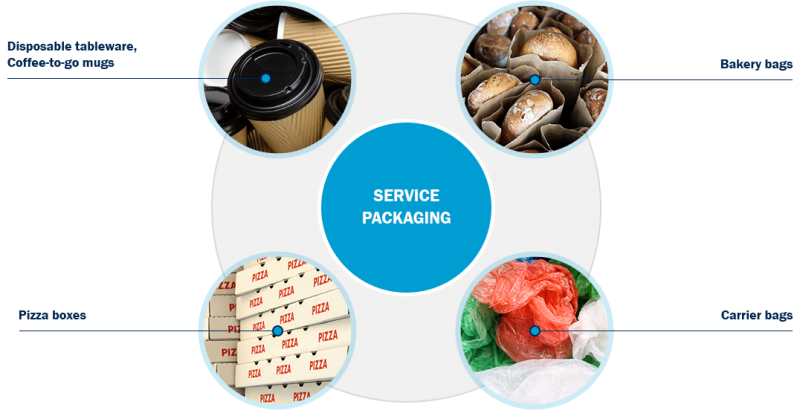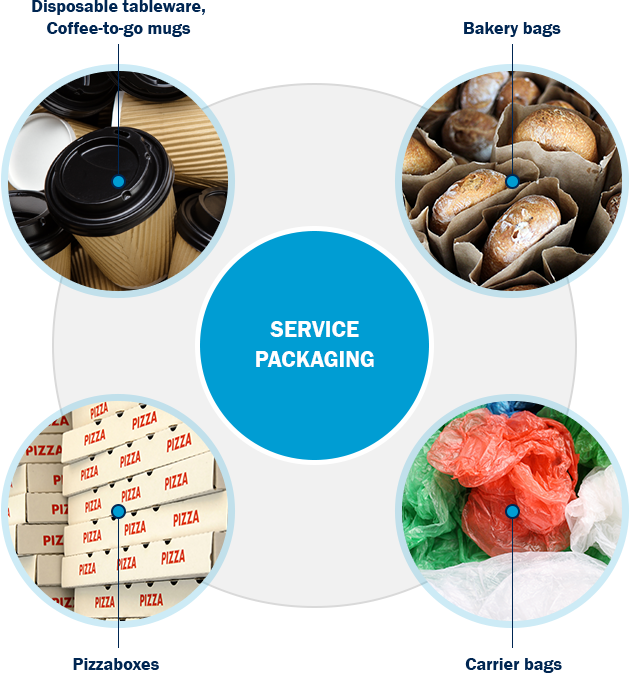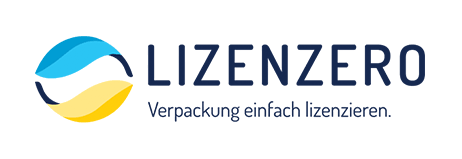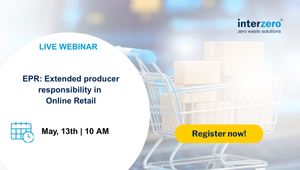
Packaging licence fees
As a result of the higher recycling targets introduced by the new German Packaging Act (VerpackG), new packaging licensing fees now also apply, although these charges are set individually by each dual system operator. This requirement to participate in a dual system, along with the payment of the fee to cover its services, was first introduced by the Packaging Ordinance.
This basic premise, whereby initial distributors of packaging bear the take-back and recycling costs for packaging waste according to the principle of product responsibility, is further upheld by the Packaging Act. Accordingly, all companies who sell packaging to private end users must pay for the collection, disposal and recycling of the sales packaging placed on the market, and must also ‘license’ this packaging beforehand. The licence fees charged are primarily based on the volume of packaging placed on the market and the type of packaging materials used.
These fees can be calculated using websites such as www.lizenzero.de, where practical tools and calculation aids are offered for working out the individual licence fee to be paid, and which can convert the volumes specified per packaging material into the corresponding packaging licence fees. Lizenzero offers packaging licensing from an annual fee of just EUR 39.00.
Table of contents
- ‘Amending’ the Packaging Ordinance or: the new Packaging Act
- The Central Agency Packaging Register (ZSVR)
- Who is responsible for the take-back and recycling of waste?
- Terminology: the ‘manufacturer’ as defined by the Packaging Act
- Selecting a dual system
- Packaging licence fees
- What is pre-licensed packaging?
‘Amending’ the Packaging Ordinance or:
the new Packaging Act
The new German Packaging Act (VerpackG) is not an amendment to the Packaging Ordinance (VerpackV) but replaces the earlier ordinance entirely from 1 January 2019. The Packaging Ordinance, which entered into force in 1991, received several amendments during its lifetime, the last of which was adopted on 29 July 2017. The VerpackV is considered to be a precursor to (and later an integral part of) the Circular Economy Act (KrWG) enacted in 1996.
The first version of the Ordinance took effect on 1 December 1991 and the Ordinance entered into force in its entirety on 1 January 1993. The Ordinance aimed at safeguarding the take-back and recycling of packaging by the companies first placing it on the market, while also requiring these companies to participate in a dual system.
Given the lack of a monitoring body, however, many companies circumvented their participation duties, acting as ‘free riders’ within the system. As a result, the companies who complied properly with the requirement to pay packaging licence fees found themselves financing packaging disposal and recycling for other companies who did not participate in cost sharing as envisaged by VerpackV.
This issue, alongside other aspects, resulted in the creation of the new Packaging Act (VerpackG) – full title Act Regulating the Placing on the Market, Take-Back and High-Quality Recycling of Packaging – that was adopted and passed into federal law on 5 July 2017.
The Central Agency Packaging Register (ZSVR)

The new Act establishes the Central Agency Packaging Register (ZVSR) as a body to monitor compliance with its regulations. All manufacturers and distributors who place sales packaging on the market are now required to register with the Central Agency. Accordingly, all packaging placed on the market must not only be registered with a dual system chosen by the manufacturer/retailer but also reported to this Central Agency Packaging Register (ZSVR).
Since all data about manufacturers and brands is made public via the Register’s LUCID database, competitors and business partners also have access to this data, and can take legal action in the case of suspected breaches of the law. Failing to comply with the letter of the law is a regulatory infringement and can be punished with fines of up to EUR 200,000 or a ban on product sales.

The new Act establishes the Central Agency Packaging Register (ZVSR) as a body to monitor compliance with its regulations. All manufacturers and distributors who place sales packaging on the market are now required to register with the Central Agency. Accordingly, all packaging placed on the market must not only be registered with a dual system chosen by the manufacturer/retailer but also reported to this Central Agency Packaging Register (ZSVR).
Since all data about manufacturers and brands is made public via the Register’s LUCID database, competitors and business partners also have access to this data, and can take legal action in the case of suspected breaches of the law. Failing to comply with the letter of the law is a regulatory infringement and can be punished with fines of up to EUR 200,000 or a ban on product sales.
Terminology: the ‘manufacturer’ as defined by the Packaging Act
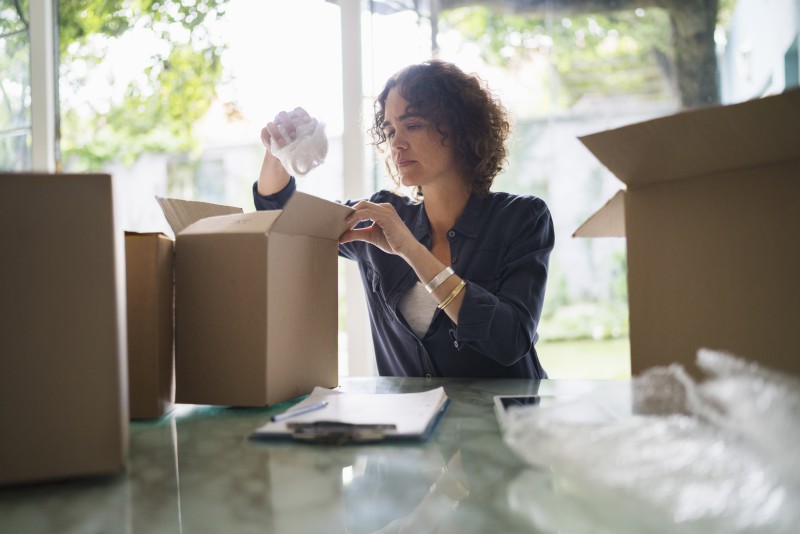
A key part of this concept is the definition of the ‘manufacturer’ given in Section 3(14): The Act not only restates the usual meaning of the word, namely a company that makes a certain good, but extends it to mean anyone who first fills packaging with goods and places it on the market. This definition therefore also encompasses distributors and retailers when they act as initial fillers of sales packaging (including its subtypes of product packaging, service packaging and/or mail-order packaging). In cases where the Central Agency refers to ‘manufacturers’, it therefore means manufacturers as well as retailers and distributors of goods where these latter companies match the definition of an ‘initial distributor’ of packaging.
Accordingly, online retailers who sell their goods via an online shop and/or platforms such as eBay, Amazon or Etsy are also required to pay the relevant packaging licence fees.
Manufacturers who use transport packaging (packaging that is not supplied to end users, such as shipping cartons palletised with plastic wrap) are not required to participate in a dual system. The take-back and recycling of this kind of packaging is regulated by Section 15 of the VerpackG. Registration with the Central Agency Packaging Register is not required for transport packaging. Interzero also offers take-back and recycling solutions for transport packaging.

A key part of this concept is the definition of the ‘manufacturer’ given in Section 3(14): The Act not only restates the usual meaning of the word, namely a company that makes a certain good, but extends it to mean anyone who first fills packaging with goods and places it on the market. This definition therefore also encompasses distributors and retailers when they act as initial fillers of sales packaging (including its subtypes of product packaging, service packaging and/or mail-order packaging). In cases where the Central Agency refers to ‘manufacturers’, it therefore means manufacturers as well as retailers and distributors of goods where these latter companies match the definition of an ‘initial distributor’ of packaging.
Accordingly, online retailers who sell their goods via an online shop and/or platforms such as eBay, Amazon or Etsy are also required to pay the relevant packaging licence fees.
Manufacturers who use transport packaging (packaging that is not supplied to end users, such as shipping cartons palletised with plastic wrap) are not required to participate in a dual system. The take-back and recycling of this kind of packaging is regulated by Section 15 of the VerpackG. Registration with the Central Agency Packaging Register is not required for transport packaging. INTERSEROH Dienstleistungs GmbH also offers take-back and recycling solutions for transport packaging.
Who is responsible for the take-back and recycling of waste?
Responsibility for the take-back and recycling of packaging waste is borne by the companies who place sales packaging on the market, who therefore also pay the associated packaging licence fees. The criterion applied here is that of the ‘initial distributor’. An initial distributor is a manufacturer or retailer who fills sales packaging with goods for the first time, and then distributes this unit of goods and packaging to a private end user. Initial distributors are legally responsible for paying the packaging licence fees. This licence fee payment must be made to an operator of a dual system – such as Interzero Recycling Alliance, for example, whose Lizenzero online shop greatly simplifies the packaging licensing process.
Selecting a dual system
When the dual system was first launched, there was only one dual system operator: Der Grüne Punkt. The EU Commission took steps to end the monopoly enjoyed by Der Grüne Punkt – das Duale System Deutschland GmbH (DSD). As a result, there are now several companies who offer licensing services for packaging placed on the market. These operators of dual systems are sometimes referred to as ‘dual systems’ themselves. Today, there are now eleven accredited dual system operators in Germany, one of whom is Interzero Recycling Alliance GmbH.
Packaging licence fees
Packaging licence fees can be worked out easily using the user-friendly calculation tool offered by the lizenzero website. These fees are based on the volume of packaging placed on the market and the packaging materials used. As a rule, licensing is required for all packaging materials:
- Paper, paperboard and cardboard (PPC) (shipping cartons, folding cartons, packing paper, etc.)
- Plastics (plastic bags, wrap, blister packs, jars, etc.)
- Glass (non-reusable bottles and jars)
- Aluminium (bottle caps, tubes used for cosmetic products, etc.)
- Beverage cartons (consisting of the carton itself plus a very thin aluminium or plastic liner)
- Other materials (wood, rubber, cotton, copper, ceramics, etc.)
- Other composite packaging (vacuum packaging used for coffee, etc.)
- Ferrous metals (food and drink cans, bottle caps, etc.)
The data reports that companies must make to both the Central Agency and to their chosen dual system are always based on the total weights of each of the packaging materials used. If a company does not have the figures for their individual volumes, the Lizenzero Calculation Wizard can be used to convert these volumes into kilos by simply entering the number of items used for each of a range of standard packaging types. The calculation tool then uses this input to work out the corresponding total weight per packaging material. Examples of the standard packaging types used to calculate the packaging licence fees include shipping cartons with and without filling material, air cushion envelopes, padded envelopes, plastic wrap, and glass bottles and containers.
After calculating the packaging volumes and weights, Lizenzero then displays the customer’s individual licensing fee. Various payment methods are accepted for payment of the packaging licence fees. Customers should remember that participation in a dual system (packaging licensing) must also be followed by registration and reporting packaging volume data to the ZSVR. A failure to complete this step means the company is not compliant with the provisions of the Packaging Act.
Choose your packaging type:
-
Resources saved:
Resources saved
(Source: Fraunhofer UMSICHT)Here you can see how many kilograms of primary raw materials you save with your packaging licensing and its associated recycling. To clearly illustrate the volume saved, we also use a diagram containing the corresponding number of apples.
The calculated values are based on an annual study from the prestigious Fraunhofer Institute for Environmental, Safety and Energy Technology (UMSICHT).
We state the volume of primary raw materials saved and greenhouse gas emissions reduced by your company’s partnership with Interseroh on your personal resource protection certificate.
- 0 kg
- ≈ 0
Box S
Box S
Our reference box has the following specification:
Dimensions: 25,0 x 17,5 x 10,0 cm
Weight: Paper/paperboard/cardboard 65 g
Example: DHL Package S
Box S
incl. packing tape
Box S - incl. packing tape
Our reference box has the following specification:
Dimensions: 25,0 x 17,5 x 10,0 cm
Weight: Paper/paperboard/cardboard 65 g, plastic 2 g
Example: DHL Package S wrapped with PVC packing tape
Box S
incl. packing tape and paper filling material
Box S - incl. packing tape and paper filling material
Our reference box has the following specification:
Dimensions: 25,0 x 17,5 x 10,0 cm
Weight: paper/paperboard/cardboard 70 g, plastic 2 g
Example: DHL Package S wrapped with PVC packing tape + Kraft paper or wood wool
Box S
incl. packing tape and synthetic filling material
Box S - incl. packing tape and synthetic filling material
Our reference box has the following specification:
Dimensions: 25,0 x 17,5 x 10,0 cm
Weight: paper/paperboard/cardboard 65 g, plastic 12 g
Example: DHL Package S wrapped with PVC packing tape + bubble wrap with small bubbles
Air Cushion Envelope S
made of paper
Air bubble envelope S - made from paper
Our reference envelope has the following specification:
Dimensions: 180 x 265 mm
Weight: paper/paperboard/cardboard 15 g, plastic 2 g
Example: Padded paper envelope, DIN B5 format, lined inside with bubble wrap, size D4
Box M
Box M
Our reference box has the following specification:
Dimensions: 37,5 x 30,0 x 13,5 cm
Weight: paper/paperboard/cardboard 275g
Example: DHL Package M
Box M
incl. packing tape
Box M - incl. packing tape
Our reference box has the following specification:
Dimensions: 37,5 x 30,0 x 13,5 cm
Weight: paper/paperboard/cardboard 4 g
Example: DHL Package S wrapped with PVC packing tape
Box M
incl. packing tape and paper filling material
Box M - incl. packing tape and paper filling material
Our reference box has the following specification:
Dimensions: 37,5 x 30,0 x 13,5 cm
Weight: paper/paperboard/cardboard 300 g, plastic 4 g
Example: DHL Package M wrapped with PVC packing tape + kraft paper or wood wool
Box M
incl. packing tape and synthetic filling material
Box M - incl. packing tape and synthetic filling material
Our reference box has the following specification:
Dimensions: 37,5 x 30,0 x 13,5 cm
Weight: paper/paperboard/card 275 g, plastic 24 g
Example: DHL Package M wrapped with PVC packing tape+ bubble wrap with small bubbles
Air bubble envelope M
made of paper
Air bubble envelope M - made from paper
Our reference envelope has the following specification:
Dimensions: 220 x 340 mm
Weight: paper/paperboard/cardboard 22 g, plastic 3 g
Example: Padded paper envelope, DIN A4 format, lined inside with bubble wrap, size F6
Box L
Box L
Our reference box has the following specification:
Dimensions: 45,0 x 35,0 x 20,0 cm
Weight: paper/paperboard/cardboard 400 g
Example: DHL Package L
Box L
incl. packing tape
Container L - incl. packing tape
Our reference box has the following specification:
Dimensions: 45,0 x 35,0 x 20,0 cm
Weight: paper/paperboard/cardboard 400 g, plastic 6 g
Example: DHL Package L wrapped with PVC packing tape
Box L
incl. packing tape and paper filling material
Box L - incl. packing tape and paper filling material
Our reference box has the following specification:
Dimensions: 45,0 x 35,0 x 20,0 cm
Weight: paper/paperboard/cardboard 500 g, plastic 6 g
Example: DHL Package L wrapped with PVC packing tape + bubble wrap with small bubbles
Box L
incl. packing tape and synthetic filling material
Box L - incl. packing tape and synthetic filling material
Our reference box has the following specification:
Dimensions: 45,0 x 35,0 x 20,0 cm
Weight: paper/paperboard/cardboard 400 g, plastic 36 g
Example: DHL Package L wrapped with PVC packing tape + bubble wrap with small bubbles
Air Cushion Envelope L
made of paper
Air bubble envelope L - made from paper
Our reference envelope has the following specification:
Dimensions: 300 x 445 mm
Weight: paper/paperboard/cardboard 40 g, plastic 5 g
Example: Padded paper envelope, DIN A3 format, size I9
-
Resources saved:
Resources saved
(Source: Fraunhofer UMSICHT)Here you can see how many kilograms of primary raw materials you save with your packaging licensing and its associated recycling. To clearly illustrate the volume saved, we also use a diagram containing the corresponding number of apples.
The calculated values are based on an annual study from the prestigious Fraunhofer Institute for Environmental, Safety and Energy Technology (UMSICHT).
We state the volume of primary raw materials saved and greenhouse gas emissions reduced by your company’s partnership with Interseroh on your personal resource protection certificate.
- 0 kg
- ≈ 0
Shipping envelope S
without filling material
Shipping envelope S - without filling material
Our reference shipping envelope has the following specification:
Dimensions: 165 x 220 mm
Weight: plastic 10 g
Example: Plastic shipping bag for textile and courier shipping
Packaging cup S
Packaging cup S
Our reference packaging cup has the following specification:
Dimensions: Ø 15,5 cm x 6,8 cm (Capacity 500 ml)
Weight: plastic 19,4 g
Example: Salad bowls with hinged lid. Made of PET
Film S
Film S
Our reference film has the following specification:
Dimensions: 30 x 100 cm
Weight: Plastic 22 g
Example: Blown film or bubble wrap with large bubbles
Shipping envelope M
without filling material
Shipping envelope M - without filling material
Our reference shipping envelope has the following specification:
Dimensions: 245 x 320 mm
Weight: plastic 12 g
Example: Plastic shipping bag for textile and courier shipping
Packaging cup M
Packaging cup M
Our reference packaging cup has the following specification:
Dimensions: Ø 17,6 cm x 7,5 cm (Capacity 750 ml)
Weight: plastic 24,6 g
Example: Salad bowls with hinged lid. Made of PET
Film M
Film M
Our reference film has the following specification:
Dimensions: 60 x 200 cm
Weight: Plastic 45 g
Example: Blown film or bubble wrap with large bubbles
Shipping envelope L
without filling material
Shipping envelope L - without filling material
Our reference shipping envelope has the following specification:
Dimensions: 400 x 500 mm
Weight: plastic 15 g
Example: Plastic shipping bag for textile and courier shipping
Packaging cup L
Packaging cup L
Our reference packaging cup has the following specification:
Dimensions: Ø 18,9 cm x 8 cm (Capacity 1000 ml)
Weight: plastic 27,1 g
Example: Salad bowl with hinged lid. Made of PET
Film L
Film L
Our reference film has the following specification:
Dimensions: 120 x 200 cm
Weight: Plastic 90 g
Example: Blown film or bubble wrap with large bubbles
-
Resources saved:
Resources saved
(Source: Fraunhofer UMSICHT)Here you can see how many kilograms of primary raw materials you save with your packaging licensing and its associated recycling. To clearly illustrate the volume saved, we also use a diagram containing the corresponding number of apples.
The calculated values are based on an annual study from the prestigious Fraunhofer Institute for Environmental, Safety and Energy Technology (UMSICHT).
We state the volume of primary raw materials saved and greenhouse gas emissions reduced by your company’s partnership with Interseroh on your personal resource protection certificate.
- 0 kg
- ≈ 0
Bottle / jar S
with lid (plastic)
Bottle / jar S with lid – plastic
Our reference bottle/jar has the following specification:
Dimensions: Capacity 250 ml
Weight: glass 150 g, plastic 1 g
Example: Bottle with plastic lid
Bottle / jar S
with lid (aluminium)
Bottle / jar S with lid (aluminium)
Our reference bottle/jar has the following specification:
Dimensions: Capacity 250 ml
Weight: gass 150 g, aluminium 1 g
Example: Bottle with aluminium lid / cork stopper
Bottle / jar S
with lid (cork)
Bottle / jar S with lid (cork)
Our reference bottle/jar has the following specification:
Dimensions: Capacity 250 ml
Weight: glass 150 g, Other materials 1 g
Example: Bottle with cork stopper
Bottle / jar M
with lid (plastic)
Bottle / jar M with lid – plastic
Our reference bottle/jar has the following specification:
Dimensions: Capacity 750 ml
Weight: glass 500 g, plastic 1 g
Example: Bottle with plastic lid
Bottle / jar M
with lid (aluminium)
Bottle / jar M with lid (aluminium)
Our reference bottle/jar has the following specification:
Dimensions: Capacity 750 ml
Weight: glass 500 g, aluminium 1 g
Example: Bottle with aluminium lid
Bottle / jar M
with lid (cork)
Bottle / jar M with lid (cork)
Our reference bottle/jar has the following specification:
Dimensions: Capacity 750 ml
Weight: glass 500 g, other materials 1 g
Example: Bottle with cork stopper
Bottle / jar L
with lid (plastic)
Bottle / jar L with lid – plastic
Our reference bottle/jar has the following specification:
Dimensions: Capacity 1 l
Weight: glass750 g, plastic1 g
Example: Bottle with plastic lid
Bottle / jar L
with lid (aluminium)
Bottle / jar S with lid (aluminium)
Our reference bottle/jar has the following specification:
Dimensions: Capacity 1 l
Weight: glass 750 g, aluminium 1 g
Example: Bottle with aluminium lid
Bottle / jar L
with lid (cork)
Bottle/jar L with lid - Kork
Our reference bottle/jar has the following specification:
Dimensions: Capacity 1 l
Weight: Glass 750 g, Other materials 1 g
Example: Bottle with cork stopper
Paper, cardboard 0,000 kg
Plastics 0,000 kg
Glass 0,000 kg
Your license package:
Your annual licence contract includes the VerpackG-compliant licensing of the entered packaging quantities, the online seal as proof of your system participation, your annual Resources SAVED certificate and a service flat rate. To ensure that you are permanently legally compliant and do not have to worry about this every year, the contract is extended at the beginning of each year. You can cancel the contract yourself in your customer account up to 3 months before the end of each year.
25,00 € plus VAT
What is pre-licensed packaging?
Pre-licensed packaging is a special case and is now generally prohibited by the provisions of the new Packaging Act. There is one exception, namely ‘service packaging’ (also a subtype of sales packaging): this kind of packaging may indeed be purchased as pre-licensed packaging from the packaging manufacturer. However, the burden of proof that the packaging is in fact properly licensed is borne by the last distributor. Accordingly, this distributor should always have the licensing of the packaging confirmed by the packaging supplier or manufacturer. Service packaging is packaging that is used for the direct handover of the product to the end user – such as coffee-to-go cups or the paper bags typically used to transport sandwiches or baked goods.
